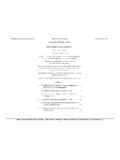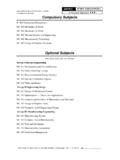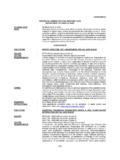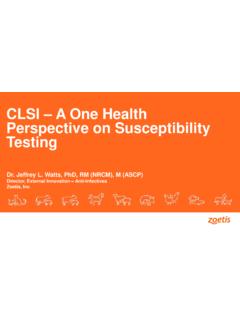Transcription of Syllabus of AMIE Exams (Section B, Electrical …
1 Syllabus OF ELECTRONICS OF AMIE Exams ELECTRONICS & communication ENGINEERING FIRST FLOOR, CITY PRIDE COMPLEX, CIVIL LINES, ROORKEE , UTTARAKHAND PH: +91 9412903929 Web: AMIE(I) STUDY CIRCLE(REGD.) A Focused Approach Compulsory Subjects IC 402 Engineering Management EC 403 communication Engineering EC 404 Circuit Theory and Control EC 405 Micro-processors and Micro-controllers EC 406 Electronic Circuits EC 407 Design of Electronic Devices and Circuits Optional Subjects (Any three from any one Group) Group I Telecommunication Engineering EC 411 Broadcast and Television Engineering EC 412 Radar and Antenna Engineering EC 413 Microwave Engineering EC 414 Optical and Satellite communication EC 415 Computer Networks and communication Group II Integrated Circuits & Systems Engineering EC 421 Digital Hardware Design EC 422 Pulse and Digital Circuits EC 423 IC Design Techniques EC 424 Solid State Physics and Semiconductor Devices EC 425 Software Engineering Group III Control and Instrumentation EC 431 Sensors and Transducers EC 432 Industrial Instrumentation and Computer Control EC 433 Biomedical Electronics EC 434 Signal Processing EC 435 Control Systems Syllabus OF ELECTRONICS OF AMIE Exams ELECTRONICS & communication ENGINEERING FIRST FLOOR, CITY PRIDE COMPLEX, CIVIL LINES, ROORKEE , UTTARAKHAND PH.
2 +91 9412903929 Web: AMIE(I) STUDY CIRCLE(REGD.) A Focused Approach Engineering Management Group A Management and Organisations Management process: Definition, planning organizing, directing, controlling, coordinating, types of management. Organisation Definition, planning, design and development, types of organizations. Management planning and control: Classical, new classical and modern principles. General Management, scientific management, engineering, management, systems management. Planning: Procedures, resources and constraints, objectives, goals, policies and procedures. Control: Setting of reference or standards, appraisal or evaluation, monitoring and controlling, types of control. Human resource planning and management, selection, recruitment, training, retraining, skill development, competence development, promotion and career development, participative management, trade unions, and collective bargaining, Management of Physical Resources Plant: site selection procedures, factors affecting selection.
3 Layout-types and relative merits and demerits, Maintenance-Objectives, different types of associated decisions, strategies for effective maintenance, computer applications. Material : Functions, objectives, planning and control including inventory models with or without storage costs, price break ( excluding dynamic and probabilistic considerations). Different classes of inventory. Material Requirement Planning (MRP). Group B Financial management: Introduction to standard forms of financial statements, ie., balance-sheet, profit and loss, and income statement. Fixed and current asset items. Fixed and current liability items. Linkage of two successive balance-sheets through income or profit and loss statement. Funds flow statement. Financial ratios and their implications.
4 Managerial economics: Concepts, theory of production, marginal productivity and cost. Introduction to theory of firm. Quality management: Quality definition, quality planning, quality control and quality management, Total quality management, ISO 9000 systems, simple quality control techniques like control charts and acceptance sampling. Marketing management consumer behavior, market research, product design and development pricing and promotion. Project management: Introduction. Concept of a project, project management concepts, project simulation, cost or project and means of financing, economic evaluation criteria of the project, project implementation, project planning, scheduling and monitoring, project control (PERT, CPM techniques including crashing).
5 Project evaluation. Information technology and management. Role of information, management information system and decision support system, Information technology-introduction to e-business, e-commerce and integration tools like enterprise resource planning (ERP). Syllabus OF ELECTRONICS OF AMIE Exams ELECTRONICS & communication ENGINEERING FIRST FLOOR, CITY PRIDE COMPLEX, CIVIL LINES, ROORKEE , UTTARAKHAND PH: +91 9412903929 Web: AMIE(I) STUDY CIRCLE(REGD.) A Focused Approach communication Engineering Group A Field theory: Fields, vector calculus, gradient, Divergence, curl, Gauss's laws. Stoke' theorem, Helmholtz Theorem. Electric field intensity and potential, conducting Boundaries, coaxial cylinders, Poisson's equations and Laplace equation. Ampere's circuital law, differential equation for vector potential.
6 Magnetic polarization and field intensity, boundary conditions for Band H. Faraday's law. Time varying fields, displacement current. Maxwell's equations in differential and integral forms. communication preliminaries. Signal representation in frequency and time domain. Fourier transforms, power Spectrum, energy density spectrum. ,Direct delta function. Orthogonal representatives of signals (Gram Schmidt Procedure), autocorrelation, sampling theressare (Nyquist criterion). Random signal theory. Discrete probability theory, continuous random variables, probability density functions, ergodic processes, correlation function, spectral density, white noise. Noise: Atmospheric, thermal, shot and partition noise, noise figure and experimental determination of noise figure, minimum noise figures in networks.
7 Analog communication . Modulation theory and circuits. Amplitude modulation, AM-DSB, AM-DSB/SC, AM-SSB and their comparison. Modulating and detector circuits for AM, FM and phase modulation~ Automatic frequency control. Pulse modulation. PAM, PDM, PPM, PCM, delta modulation and circuits. Principle multiplexing FDM and TDM. Group B Transmission through network: Networks with random input, auto-correlations, special density and probability density input-output relationships, envelope of sine wave plus Gaussian noise, optimum systems and nonlinear systems. Maximum signal to noise ratio' criterion. Minimum mean square error criteria, equivalent noise bandwidth. SNR in envelope detectors and PCM systems. Comparison of modulation systems. Digital communication : Basic information theory: Definition of information, entropy, uncertainty and information, rate of communication , redundancy, relation between systems capacity and information content of messages, discrete systems, discrete noisy channel, channel coding.
8 Introduction to digital communication , quantization, PCM, log-PCM, DM, DPCM, AD, PCM and LPC for speech signals, TOM. Baseband transmission, optimum detection, matched filter, optimum terminal filters. LSI pulse shapes for controlled ISI, line codes; digital RF modulation. Modems, performance of digital modulation systems. Synchronization. Timing recovery. How to Buy Study Material (Notes) for AMIE Exams You may download prospectus from our website to buy excellent study material for AMIE Exams . You will also get full access to our online support with our course which includes latest AMIE question papers, model test papers, eBooks, audio and video lectures, course updates and interactive objective questions. AMIE(I) Study Circle, Roorkee Website: | WhatsApp: 9412903929 | Email: Syllabus OF ELECTRONICS OF AMIE Exams ELECTRONICS & communication ENGINEERING FIRST FLOOR, CITY PRIDE COMPLEX, CIVIL LINES, ROORKEE , UTTARAKHAND PH: +91 9412903929 Web: AMIE(I) STUDY CIRCLE(REGD.)
9 A Focused Approach Circuit Theory & Control Group A Graph of a network. Concept of tree, concepts of loop current and node pair voltage, circuits cut-set and cut-set matrices, formulation of equilibrium equations of the loop and node basis. Mesh and nodal analysis. Laplace transform. Transient response using Laplace transform. Initial and final value theorems. Unit step, impulse, ramp functions. Laplace transform for shifted and' singular functions. The convolution integral, Fourier series, complex exponential form of the Fourier series. The frequency spectra of periodic waveforms and their relationship to Laplace transform. The concept of complex frequency, transform impedance and admittance; series .and parallel combinations. Frequency response, coupled circuits. Terminals and terminal pairs, driving point impedance, transfer functions, poles and zeros, restrictions on pole and zero locations in s-plane.
10 Analysis of 1-port and 2-port networks. Time domain behaviour from pole and zero plot, sinusoidal network functions in terms of poles and zeros. Resonance, Q and bandwidth of a circuit. Introduction to synthesis of passive networks: Butterworth s, Chebyshev and Bessel type low pass, high pass, band pass and band rejection filters. Group B Introduction: Basic concepts and symbols, open loop and closed loop systems, effects of feedback. Concepts of linear and nonlinear systems. Definition of transfer function. Block diagram representation. Signal flow graphs. Servo components: Mathematical modelling and simulation of dynamic systems. Synchros, potentiometers, gyros. and servomotors. and tachogenerators. Power and preamplifiers. Modulators and demodulators.










